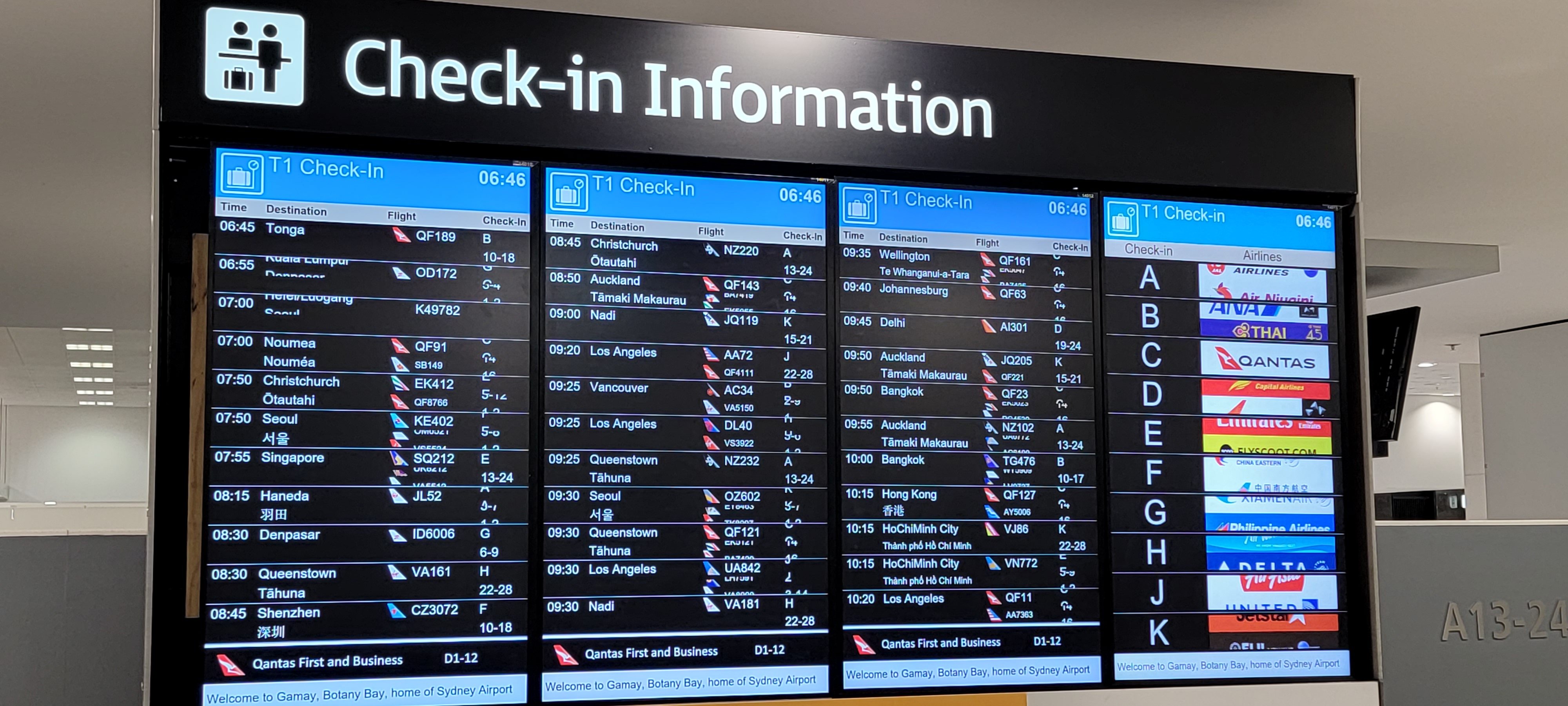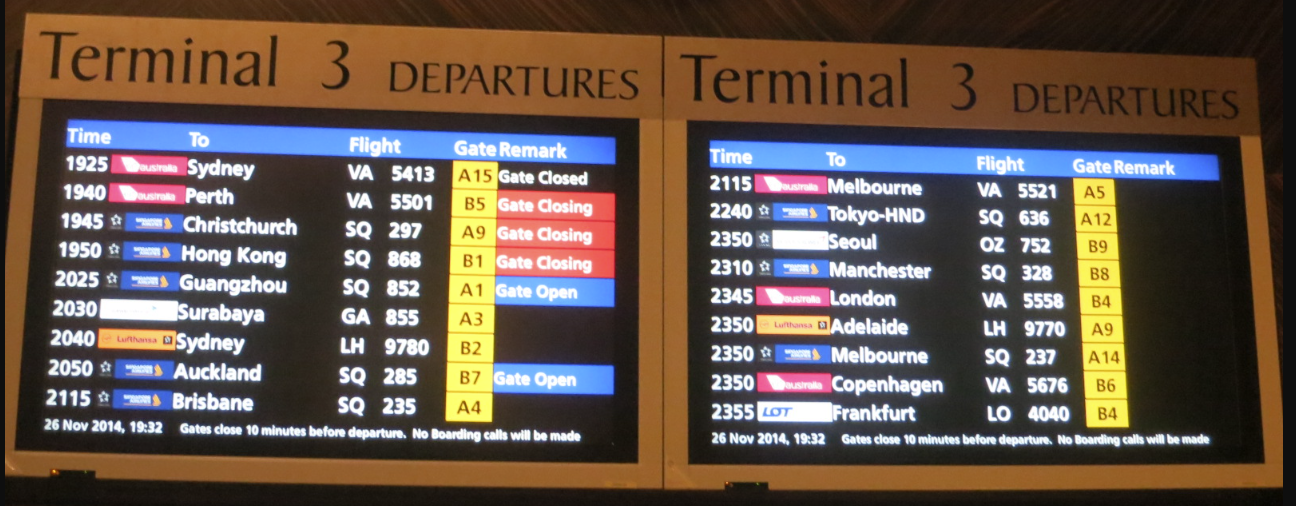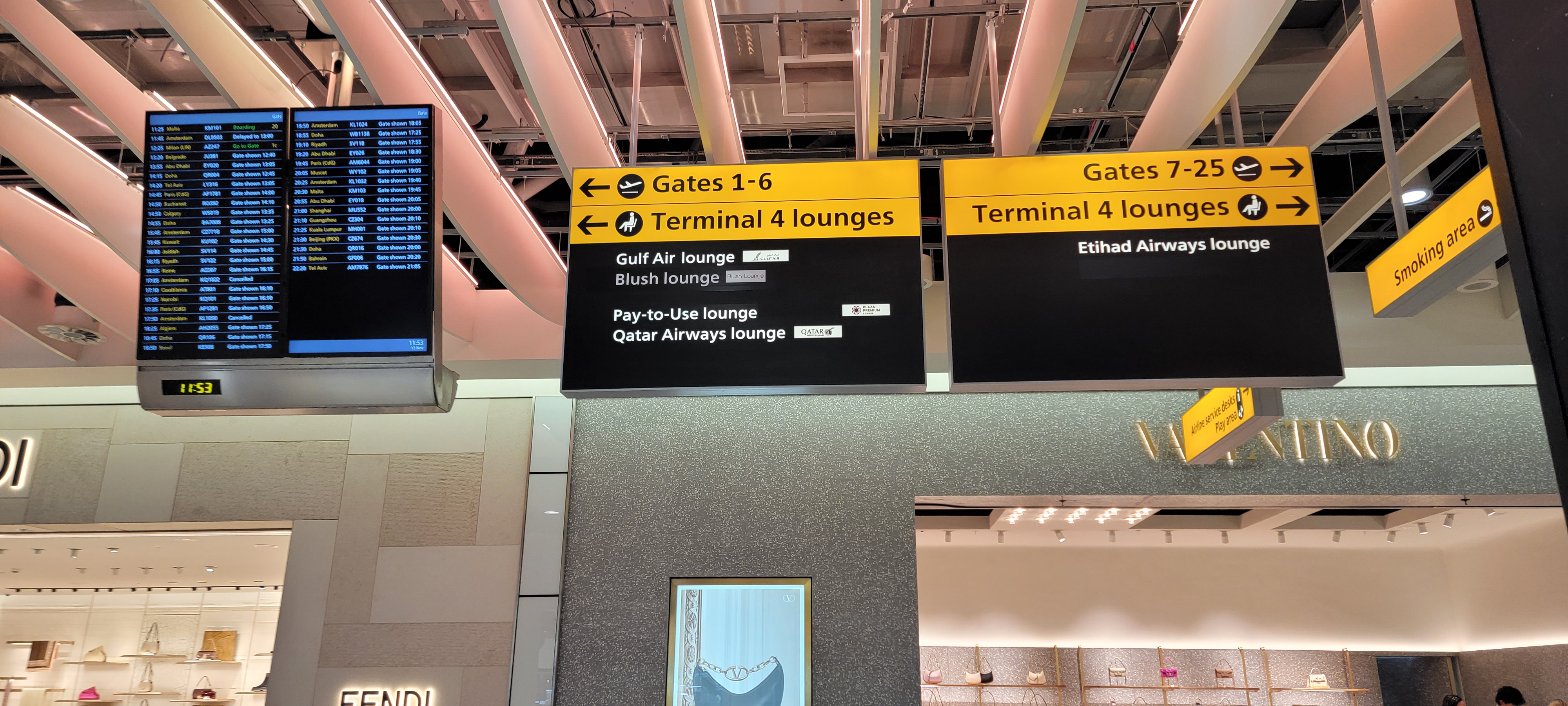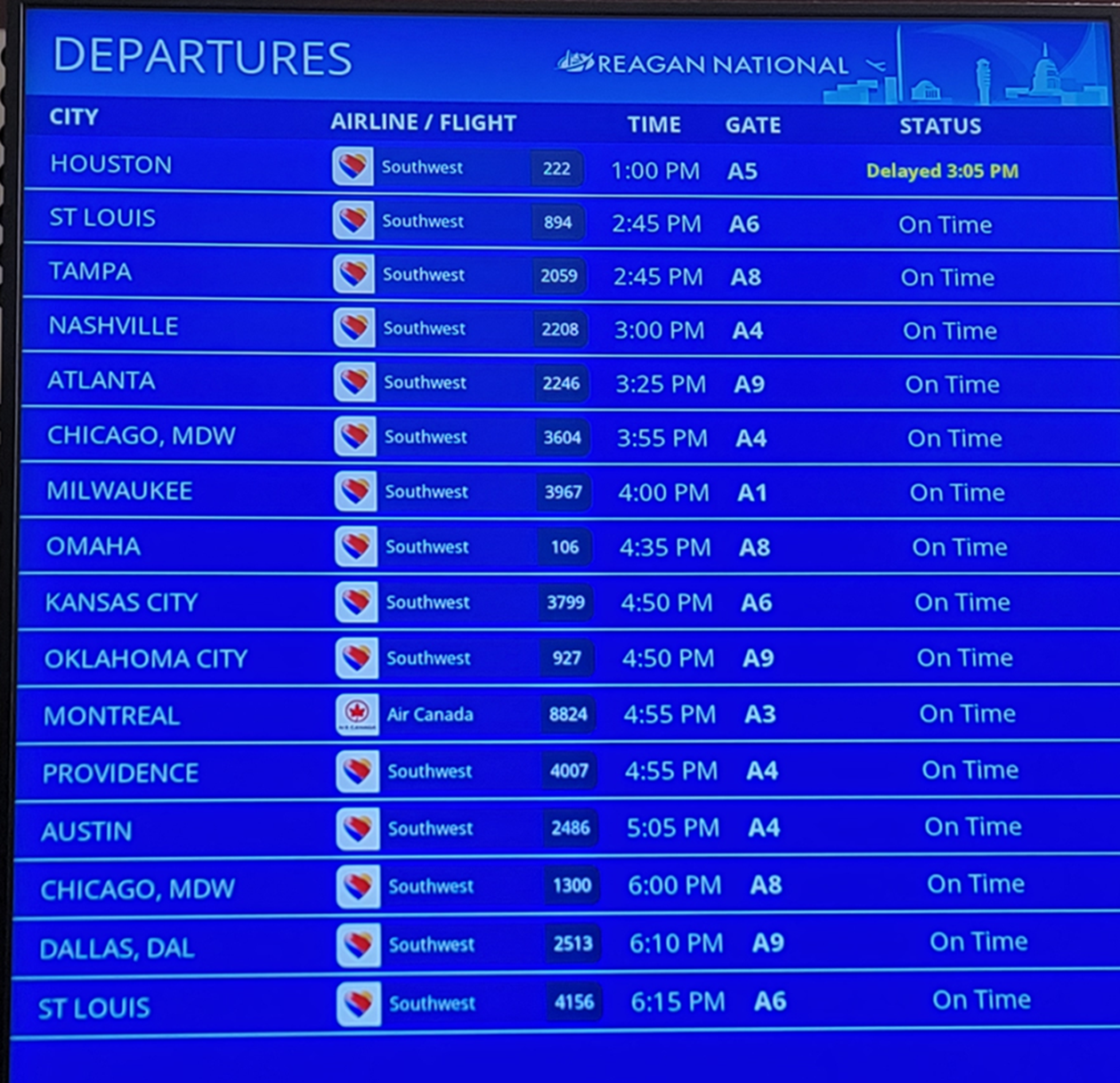For the most part, airport departure boards in the U.S. list flights alphabetically by destination. This makes sense. It makes it easy to find your flight, whether or not it’s on time, and what gate it’s leaving from.
In much of the rest of the world, it does not work like this. Departures boards are organized by departure time. You have to know your exact departure time to the minute in order to find your flight.



Nate Silver celebrates the U.S. way of airporting, while noting deviation from best practices at LaGuardia:
I'm glad the new LGA is an "international quality" airport. But the American tradition of listing flights in order of destination rather than departure time is clearly better, so this is a mistake. Almost as bad as thinking Celsius is better than Fahrenheit. pic.twitter.com/9eYs4WPH5R
— Nate Silver (@NateSilver538) September 10, 2024
Silver is correct. Organizing by destination allows passengers to quickly find flights without needing to know their exact departure time. Is my flight leaving at 9:30 a.m. or 9:40 a.m.? It doesn’t matter. I just need to know where I’m going and roughly when.
Flights ordered by departure time only makes sense – and even then, barely – at an airport like London Heathrow where they don’t announce what gate you’ll be departing from until you need to rush to the gate. They do this to keep you from going to your gate, so you’ll stay shopping longer.

Organizing by scheduled departure time gets really confusing, by the way, for flights operating with long delays.
In fairness, organizing by destination makes a lot of sense where there are numerous flights going to the same place. At many international airports, there may be more destinations but with fewer frequencies. That’s not always true. There are plenty of Madrid – Barcelona flights, for instance! But it seems like it’s even more important to organize by destination in the United States.
And not all departures boards are organized by destination here. The one in the Admirals Club I frequent most in Austin has a departures board listing flights by time. But those are just American Airlines flights – and after drawing down their regional jet operation there aren’t nearly so many flights in any case.
Oddly, here’s the departures board in the old terminal 1 at Washington’s National airport (‘the banjo’) showing flights by departure time and not destination.

There are only 9 gates in that terminal so it’s not nearly so hard to find your flight. Still, alphabetically by city would be easier!


Next thing you know the US will be adopting the metric system.
Alpha only makes sense when the whole alphabet can be displayed. You have to wait minutes for your city to come up in rotation; blink for a moment and its passed, and you have to start again.
OK, now do “why do checkers in European supermarkets do their job sitting, while in the US the job is done standing”?
Here here!
Alpha is also best when you want to find alternative flights to the same destination. I often do this in DFW to see if I can grab an earlier flight. Difficult to do this when you can’t easily find the destination you are seeking.
I completely disagree with the tweet and the article. Listing flights by departure time is much more practical, especially if you’re running late to the airport or gate. Your flight will be right at the top based on its time.
For connecting flights in unfamiliar airports, relying on the airport name can be tricky—do you even remember what it starts with? Like IAD—does that start with an “I”…? Time, however, is universal. You might not know your exact departure time, but it’s surprising if you don’t at least know the general time, like around 1 p.m. Once you’re in the right window, it’s easy to spot your airline logo or destination.
Also, Celsius and the metric system are far more intuitive!
regardless of how they are listed, it is beyond maddening to look at a departure board and see a rotation of a multitude of codeshare flights making it virtually impossible to find the operating carrier flight number – which should be carrying the majority of the passengers.
Well…at least they should be organized by whatever column is on the left. That board at Washington is quite the jumble.
And I echo David’s comment about finding an earlier flight.
What about supermarket cashiers is so true. Wow. I never thought about it.
It never bothers me because I know the departure time and gate before leaving for the airport. My guess is it helps employees know which flight has not left.
Or, you could just check your flight’s departure time on the airline’s smartphone app. Like normal people do.
This is a silly article that is poorly reasoned.
For instance:
“Organizing by scheduled departure time gets really confusing, by the way, for flights operating with long delays”
That’s not how it works, the flights are sorted by the original departure time not the delayed one.
In actual fact both ways are valid ways of organizing flights – it’s a bit myopic to argue that the only way to do it is the way you’re used to.
The biggest issue is that most boards in the US can’t find all the flights on them so you have to spend a while scrolling through them. This doesn’t happen in other counties as the earliest flights tend to be fixed on the board so if you’re departure time is soon you’ll always find it quickly.
So what should airports alphabetize when cities have different names in different languages? Vienna/Wien, Milan/Mailand, Copenhagen/Kopenhagen. And that’s before we get to non-Latin scripts. There is some logic at work outside the USA that is not always obvious to English-only speaker.
On the other hand, major train stations in UK, like the one at London Gatwick, have a board showing “Next fastest train to” with the destinations and major intermediate stops sorted alphabetically.
@Denver … “normal people” do not own a mobile phone , nor a television , nor a watch .
@Gary … Normal departure boards are listed by time . TWA invented the concept .
@TimDunn … Agree that code share flights ought not be listed .
…unless you’re unfamiliar with English/the Roman alphabet. You wouldn’t like this if it was done in East Asia (China, Japan, Vietnam, etc.).
That said, I otherwise agree. Alphabetic sorting by destination makes more sense.
Sorting by destination rather than time only works when everyone speaks the same language. Is a flight from Madrid to Philly shown under Filadelfia or Philadelphia?
Claiming a destination sort is superior really only works if you want to be ignorant of every other language in the world.
Timbits, let me ask everyone this: When was the last time you looked at a flight number? It’s got to be about a decade and a half for me. Nobody does, so your argument, like anything you say about Delta, is irrelevant.
Silver, as usual is wrong about everything.
@Ben. We are in the United States. English is the main language here. I doubt we are all considered ignorant because we prefer alpha sorting. By the way, I am a boot and jean wearing country boy who happens to speak Portuguese and Japanese.
And don’t tend to frequent airports. The argument is invalid.
Language? The international language is English. I’ve seen that departure board mostly in bird tracks–but I could make out “Shanghai”, the time and the track (this was a train station) even though my Chinese is a few dozen words spoken and far less than that written. (And just as well, as all of my companions failed to hear the announcement despite being native speakers.)
@DFWsteve: I’m not saying the US does it wrong given how prevalent English is here, just that it’s dumb to think every other country should emulate the US when there are many other languages to consider, which is Gary’s thesis here.
Agree w/ Ben & James: while it’s true that alphabetical sort makes more sense when everyone speaks the same language and agrees on the sort order, it’s not the most *universal* approach. For folks who aren’t as familiar with the latin alphabet (and don’t fly as often), the departure time on their reservation or boarding pass is a good way to minimize confusion. After all, those of us who fly frequently mostly depend on our apps/phones rather than departure boards anyway.
@Tim Dunn
So, do not list code share flights. Here is a good reason to do so. I take Frankfurt as an example. Full flights going to Helsinki. At least half of the passengers getting on that flight did not originate in Frankfurt. In fact, they come in from many countries in Europe, U.S., Asia, Africa and South American. I note (because I fly to Helsinki from Frankfurt many times a year) that many passengers indeed have boarding passes issued by their originating airline; and indeed are code share flights. They are not looking for LH flights. So, they know the time the flight departs. They just want to know which gate and when their code share flight departs.
What is simple and understand by one person, is misunderstood by others. One commenter mentioned that he likes to view by destination because it gives him a choice of different airlines. But, some airports do not have that capability because there can be multiple terminals for different airlines.
But, I personally prefer it be by destination because I do not carry my boarding pass in hand, nor do I want to start viewing my mobile while being jostled by a large crowd. And when I am in the Senator Lounge in Frankfurt, I certainly do not have my pass or mobile with me while walking around in the lounge. I really hate their boarding sign that takes about three or more resetting to get to my flight by time.
Chronologically makes sense for rail departures where each train has multiple destinations. If going from Washington to Philadelphia, you don’t care if the train terminates in Philadelphia, New York, or Boston. Keeping the format the same between rail stations and airports in Europe and other rail heavy counties makes sense.
Listing by departure time is better for plane spotting.
LGA is probably doing it for the same reason as LHR….it’s turned into a big shopping and dining hall
Most airports outside of the USA will also list flights (and announce flights) using the two symbol IATA airline code. Most people don’t know the more inscrutable codes like W6 or OS!
A very ignorant post from an American who thinks that 96% of the world population is like the 4% that America represents.
In many regions, passengers can only read in their home language (the world outside of the US speaks over 100 languages), and maybe a neighbouring one, but not in English. So how do you handle that?
Without straying into Asia or Africa, if Italy adopted this stupid suggestion, I can already see American bloggers complaining seeing “Nuova York” listed on an alphabetically displayed departure board in Milano, and being completely lost when flying to China by not finding their destination (listing would be Pechino for Beijing, etc.)
Much better to advocate for the 4% to adopt the Celsius scale, literally leaving nobody else (except people living in the past) using it.
This article is why the rest of the world thinks Americans are arrogant and ignorant (I’m being nice, stupid is more accurate). It makes way more sense to list by departure time.
Rarely do I see anything in other countries run less efficiently than here.
Using China as an example, I remember flying Air China, Hainan, and China Eastern domestically.
Boarding in China was the same. About 45 before departure it was a free for all. No boarding groups, no “elite board first”, Nothing.
We always were fully boarded and ready to go 15 min before departure.
I’ve never experienced that in America.
Plus, no matter how short your flight was, you always got a meal. I also don’t recall seeing an FA older than early 30’s.
It was like domestic flying in America back in the 60’s/70’s.
The worseñt is Bogota where the display only cycles destinations starting with A through M.
Me American. American way best way. American way only way. Unga bunga.
Nonsense.
Listed by time is far better.
As the time approaches I know that the flight will be near the top of page 1.
Far better than needing to search for it in a list!
Like the date, the rest of the world has moved on in life.
There really is life outside and the world isn’t flat!
Short of clicks today? This is so ludicrous. It’s not like you have a ticket or boarding pass which lists your departure time and flight number.
Departure boards were not invented by TWA. Airports/airlines picked up the concept from train stations. And train stations were maybe even borrowing the idea of departure boards from boat operators.
I haven’t consulted a departure board in years. My phone gives me the latest in departure gates and gate changes. When taxing in from a connection I will know where my connecting flight is going out of. Why would I go looking for a departures board?
One thing I think U.S. airports really get right is that I know at least 24 hrs in advance what gate my flight is departing from. I can get to the airport and not have to hover around the flight board (or obsessively refreshing my app) to make the mad dash to the gate with hundreds of other people once they finally get around to announcing it. I can hit the lounge and relax and then leisurely stroll to my departure gate.
And even if foreign airports don’t have the same gate management as U.S. airports, even saying what general area it will depart from (e.g., A Concourse) would be a big help.
Cue the ” Americans” comments from the America-hating pseudo-sophisticates here…
The departure boards have gate info that a boarding pass may not have. And sometimes the airline apps don’t connect or have outdated info about boarding gate for who knows what reasons. Also, the departure boards sometimes show an estimated walking time to the gate and may also show if the flight is boarding or door closed. Also, there is a benefit in not having everyone walking or standing around staring into their phones when others just want to keep on moving without having to deal with an obstacle course full of phone-using zombies.
Just experienced the Euro departure board listing by time with the gate # not disclosed till 30 minutes prior to departure at KEF. The departure gate was a big as my guest bedroom, but backed up once the gate number was listed.
One thing I do appreciate with the Euro method, I did not see one “Jesus Jetway” type.
Praise the Lord!! =;-)
12h v. 24h clock was neglected. So confusing for Americans, I’m constantly converting–it’s worse than the F v C converstion. Also, the dreadful flipping through seven or more partner numbers before your flight airline and number appear for but a moment to be replaced by more partner airlines and numbers…..
Also, as long as we’re complaining, the delay times vary between the board and the app. Another source of confusion.
Chicago O’Hare’s Terminal 5, which handles numerous international flights, recently switched its Departures Boards from listings by time to listings by city. I’m a volunteer at O’Hare in that terminal, and I spend a lot of time checking the D-boards in order to help travelers. I’m quite accustomed to both systems. Both have their pluses and minuses. I have a slight personal preference for listings by time. But — for occasional travelers, I think the listings by city are probably easier.
This article is very simple American-minded. It does not make sense when more than half the world does not use the Latin Script so how the heck are they going to display departure cities in what you want here in the US? Not everyone traveling speaks English in THEIR COUNTRY, so why even bother? Again, a simple-minded article.
Flawed American exceptionalism and reasoning at its best. And this is accounting for the fact that this author travels internationally enough to realize that there is a world beyond the US
Many have already pointed out the folly of using alpha order when people do not use the same script (or even when the same alphabet, different names for the same city).
Other reasons why time makes sense: you only need to display flights for the next 5 or so hours on the screens. A random airport in the middle of Europe handles far more flights daily than many “international” airports in the US. It would be impractical or impossible to display all flights out for a day.
As for announcing gates only 30-60 minutes prior to departure? The author should surely realize that abroad, infrastructure is shared between airlines, and a gate is almost never exclusively used by a single airline/alliance by rule, even if it is done so by convention. An airplane does not need to know its gate until it is confirmed to arrive, and so it makes sense to assign a gate closer to an incoming aircraft’s arrival time. While this has the side effect of causing passengers to cluster in a central area until the gate is announced, it also means most retail and services can be centralized rather than scattered, and you don’t have random people standing near the gates when the purpose of the gate area is for boarding only.
Finally, on English being “universal” – while it’s true that English is a language understood by a majority of the world, it is understood by far by the majority as a second language (yours truly included). English does help smooth communication amongst disparate cultures and languages, but the author should be reminded that, outside the Anglosphere, we all speak English to you because you don’t speak our native tongue. To suggest airports around the world cater to English speakers (and its alphabet) is, in its essence, not the lesson a seasoned and learned traveller should be suggesting.
I usually find the flight by time if it is listed in order. I will have to look when flying from LAX to BUF soon. I usually use my boarding pass to figure out where to go and use the listings in the terminals as back ups. I got to one gate about a year ago and no one was there. After a while a gate agent dropped by to pick something up so I asked her about the flight. She told me that the gate had been changed so I went to the new gate. The old gate had absolutely no indication about the gate change. There was something inoperative at the old gate.